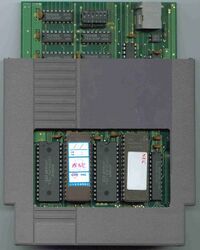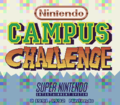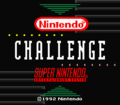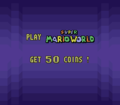Nintendo Campus Challenge: Difference between revisions
mNo edit summary |
(Super Mario focus) |
||
| (44 intermediate revisions by 26 users not shown) | |||
| Line 1: | Line 1: | ||
''' | [[File:Nintendo Campus Challenge 1991 cartridge.jpg|thumb|A cartridge used at the 1991 Nintendo Campus Challenge]] | ||
__NOTOC__ | |||
The '''{{wp|Nintendo Campus Challenge}}''' was a video game competition that was sponsored by [[Nintendo]]. The competition occurred in 1991 and 1992, and they featured a [[Nintendo Entertainment System]] version produced for the 1991 competition and a [[Super Nintendo Entertainment System]] cartridge for the 1992 competition, respectively. | |||
The 1991 Nintendo Campus Challenge cartridge features two ''[[Super Mario (franchise)|Super Mario]]'' games, ''[[Super Mario Bros. 3]]'' and ''[[Dr. Mario (game)|Dr. Mario]]'', as well as ''{{wp|Pinbot}}''. ''Super Mario Bros. 3''{{'}}s objective was to collect 25 [[coin]]s, while ''Dr. Mario''{{'}}s objective was merely to score as high as possible. After the allotted time ends, the player's scores are totaled; their score from ''Super Mario Bros. 3'' is multiplied by ten, and the score from ''Dr. Mario'' is multiplied by 100. | |||
The | |||
The | The 1992 Nintendo Campus Challenge cartridge featured only one ''Super Mario'' game, ''[[Super Mario World]]'', as well as ''[[fzerowiki:F-Zero|F-Zero]]'', and ''[[nwiki:Pilotwings|Pilotwings]]''. In ''Super Mario World'', players are required to get 50 coins, similarly to the ''Super Mario Bros. 3'' objective of the previous iteration. While the ''Super Mario World'' score was unadjusted, simply being the player's overall score at the time of completing the challenge, but the ''F-Zero'' score was multiplied by 100, and the ''Pilotwings'' score by 10,000. | ||
==Gallery== | |||
<gallery> | |||
NCCTitleScreen.png|Title screen for the Super Nintendo version | |||
NCTitleScreen.png|Title screen for the Super Nintendo version | |||
1992 Nintendo Challenge SMW.png|The screen giving players instructions for the ''Super Mario World'' part of the game | |||
</gallery> | |||
== | ==See also== | ||
*[[Nintendo World Championships]] | |||
*[[Nintendo PowerFest '94]] | |||
==External links== | |||
{{NIWA|NWiki=Nintendo Campus Challenge 1992 cartridge}} | |||
*[http://www.gamesetwatch.com/2006/06/garage_sales_unearths_nintendo.php Game Set Watch] | |||
*[http://www.snescentral.com/article.php?id=0790&usg=__jQEMZ_UsD-hmvioZFB4iSz02BKc= SNES Central] | |||
== | |||
{{NES}} | |||
[ | {{Game competitions}} | ||
[ | [[Category:Nintendo Entertainment System games]] | ||
[ | [[Category:Super Nintendo Entertainment System games]] | ||
[[Category:Game competitions]] | |||
[[Category:Platforming games]] | |||
[[Category: | [[Category:Puzzle games]] | ||
[[Category: | |||
Latest revision as of 10:23, November 2, 2023
The Nintendo Campus Challenge was a video game competition that was sponsored by Nintendo. The competition occurred in 1991 and 1992, and they featured a Nintendo Entertainment System version produced for the 1991 competition and a Super Nintendo Entertainment System cartridge for the 1992 competition, respectively.
The 1991 Nintendo Campus Challenge cartridge features two Super Mario games, Super Mario Bros. 3 and Dr. Mario, as well as Pinbot. Super Mario Bros. 3's objective was to collect 25 coins, while Dr. Mario's objective was merely to score as high as possible. After the allotted time ends, the player's scores are totaled; their score from Super Mario Bros. 3 is multiplied by ten, and the score from Dr. Mario is multiplied by 100.
The 1992 Nintendo Campus Challenge cartridge featured only one Super Mario game, Super Mario World, as well as F-Zero, and Pilotwings. In Super Mario World, players are required to get 50 coins, similarly to the Super Mario Bros. 3 objective of the previous iteration. While the Super Mario World score was unadjusted, simply being the player's overall score at the time of completing the challenge, but the F-Zero score was multiplied by 100, and the Pilotwings score by 10,000.
Gallery[edit]
See also[edit]
External links[edit]
| Game competitions | |
|---|---|
| 1980s | Disk Fax tournaments |
| 1990s | Nintendo World Championships 1990 • Nintendo Campus Challenge • Nintendo Campus Challenge 2 • World 9 challenge • Nintendo PowerFest '94 • Donkey Kong Country Competition Cartridge • Satellaview tournaments |
| 2000s | Mario Kart Wii tournaments |
| 2010s | Nintendo World Championships (2015 • 2017) |



